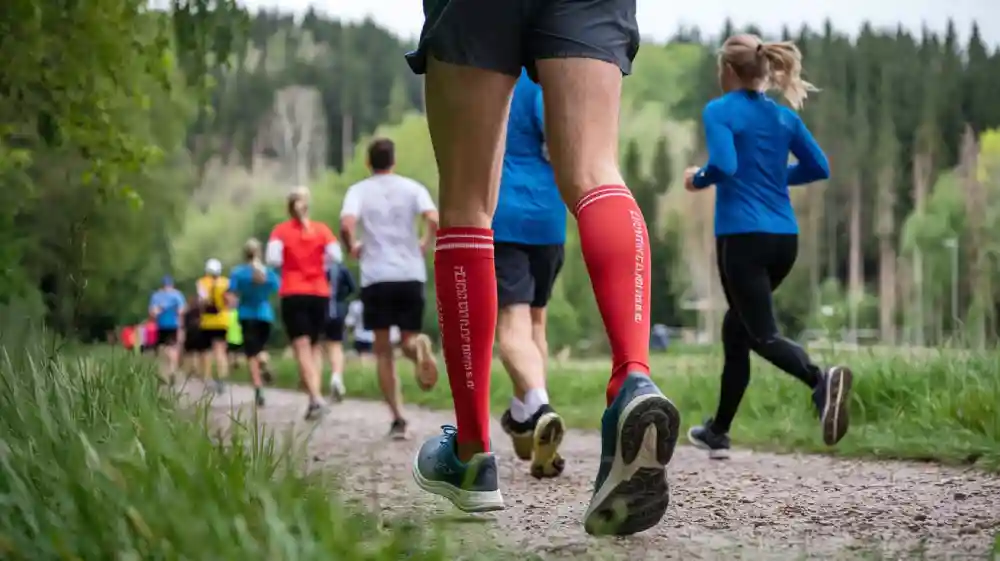
The Rising Demand for Performance-Driven Running Gear
In the dynamic world of running, athletes are continually seeking that elusive edge to enhance performance and expedite recovery. Enter compression socks—a seemingly simple yet profoundly effective solution that has garnered significant attention. These snug-fitting garments, extending from the toes to the knees, apply targeted pressure to the legs, promoting optimal blood flow and oxygen delivery to muscles. This mechanism not only aids in reducing muscle fatigue but also accelerates recovery post-run.
However, the benefits of compression socks extend beyond performance enhancement. They play a pivotal role in injury prevention by stabilizing muscles and joints, thereby mitigating the risk of strains and sprains. Additionally, they assist in managing swelling and discomfort, common complaints among runners, ensuring a more comfortable and enjoyable running experience.
For brands and retailers, understanding the multifaceted advantages of compression socks is crucial. By integrating these insights into product offerings, businesses can effectively address the diverse needs of runners, fostering customer satisfaction and loyalty.
Understanding Runners’ Biggest Pain Points
Muscle Fatigue and Long-Distance Running Challenges
Running for extended periods takes a toll on muscles. As runners push through their limits, muscle fatigue becomes inevitable, especially in the calves, quads, and hamstrings. This fatigue can significantly impair performance and recovery. Compression socks help by increasing blood flow, which delivers more oxygen to these muscles, potentially reducing the onset of fatigue and supporting longer, more efficient runs.
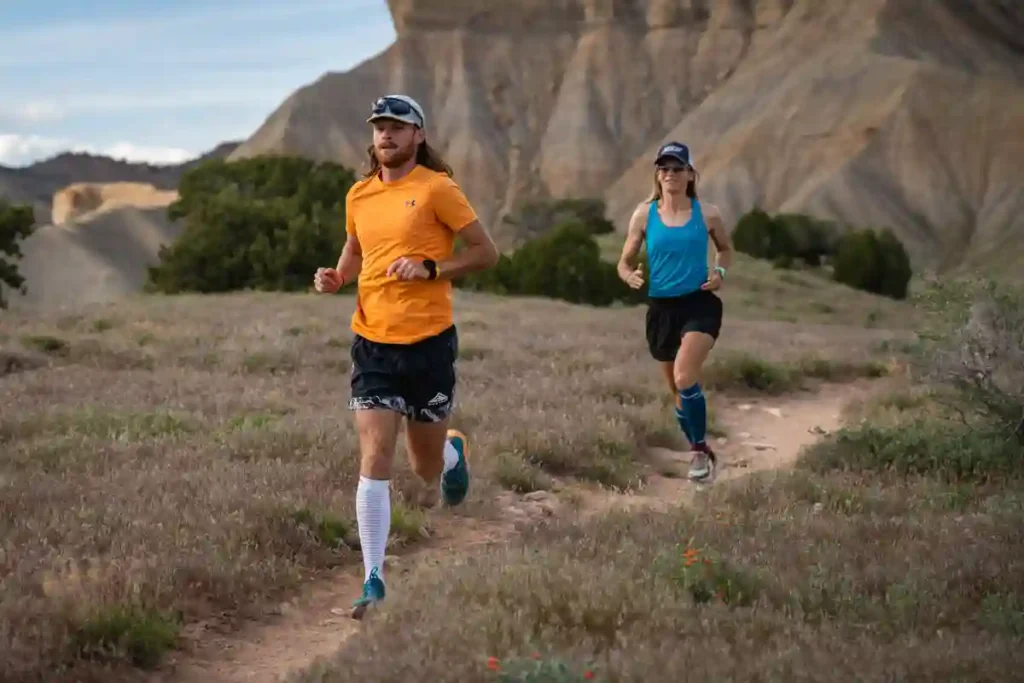
Injury Prevention: Achilles Strains, Shin Splints, and Swelling
Runners frequently face injuries like Achilles strains and shin splints due to repetitive impact and overuse during training. Compression socks help prevent these issues by stabilizing muscles and reducing vibration with every footstrike. This added support minimizes strain, especially in the calves and ankles. Specialized compression zones in the socks target the calves, offering relief for those suffering from shin splints, a common problem among long-distance runners. Moreover, these garments help reduce swelling, which can impede recovery after intense runs. By improving blood circulation, they support fluid return, aiding in faster recovery. Studies have shown that compression gear can cut injury rates by as much as 25%, highlighting its effectiveness in preventing harm and speeding up the healing process. With these advantages, compression socks serve as a practical tool to keep runners healthy and performing at their best.tion to keep runners healthy and performing at their best.
Poor Circulation and Numbness During Training
Many runners experience numbness in their feet or legs due to poor circulation, especially during long or intense workouts. Reduced circulation can lead to discomfort and decreased performance. Compression socks target these issues by providing consistent, gentle pressure, enhancing blood flow and reducing the likelihood of numbness. This added support allows for better endurance and less discomfort, enabling runners to push through their training sessions more effectively.
Blisters, Chafing, and Sock-Related Discomfort
Sock-related discomfort, such as blisters and chafing, is a common issue for runners, often caused by friction during long runs. This irritation typically occurs in high-impact areas like the heels and arches when socks shift or don’t fit properly. Compression socks are designed to provide a snug, secure fit, preventing unwanted movement and reducing friction, thus minimizing the risk of blisters and chafing. Additionally, many compression socks are made with anti-microbial fabrics that help control odor and moisture buildup, keeping feet dry and fresh throughout the run. To further enhance comfort, compression socks often feature targeted padding in high-impact areas, providing extra cushioning for the heels and arches, which alleviates pressure and reduces the potential for discomfort. This combination of features ensures a more comfortable and irritation-free running experience.

Post-Run Recovery Delays Impacting Performance
One of the biggest barriers to improved running performance is inadequate recovery. Many runners struggle with soreness and stiffness after training, leading to delayed recovery and disrupted routines. Compression socks play a significant role in post-run recovery by accelerating blood flow, which helps remove metabolic waste products like lactic acid. By promoting faster muscle repair, these socks help reduce recovery time, allowing runners to get back to training sooner and improve overall performance
Enhancing Performance and Recovery
- Delayed Onset Muscle Soreness (DOMS): Recovery Speed Matters
One of the most common hurdles after intense exercise is Delayed Onset Muscle Soreness (DOMS), which peaks 24-48 hours post-run. This soreness can significantly impact a runner’s ability to train consistently. Compression garments aid recovery by improving circulation and helping to remove metabolic waste, such as lactic acid, that contributes to soreness. By enhancing blood flow to muscles, these products help reduce the severity and duration of DOMS, allowing athletes to recover faster and return to training more quickly.
- Improving Running Form Through Ankle and Arch Support
Proper running form is essential for reducing fatigue and injury risk. Compression gear provides added support to the ankles and arches, offering stability during each stride. This support minimizes unnecessary movement and prevents strain on muscles and joints. By ensuring muscles stay aligned and well-supported, these socks help runners maintain better posture and running mechanics, ultimately improving efficiency and reducing the risk of overuse injuries.
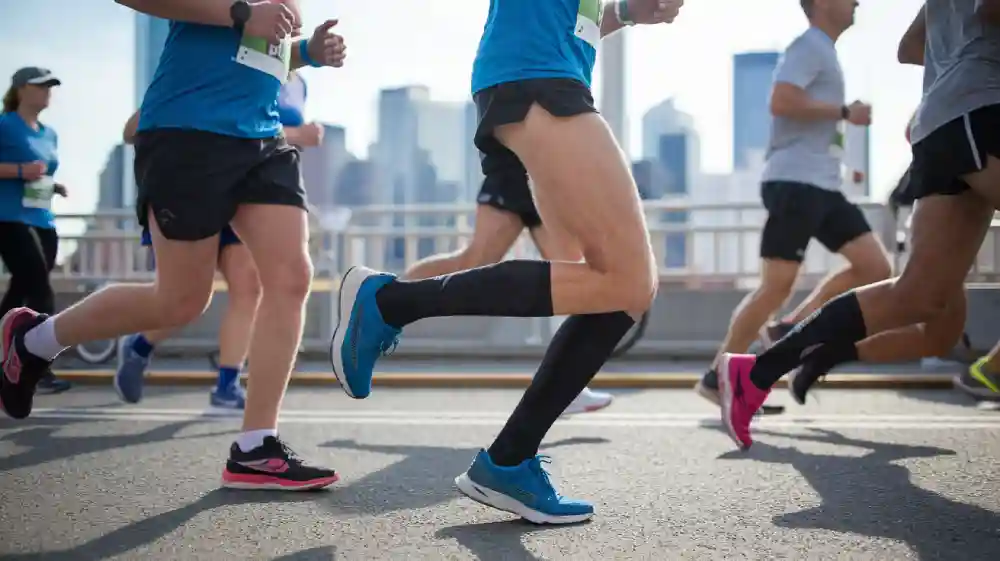
- Marathon Training: Why Pros Rely on Compression Gear
Marathon training demands intense effort, and professionals rely on compression wear to maintain peak performance and accelerate recovery. Compression socks support muscle groups during long runs, preventing swelling and reducing fatigue. During post-run recovery, they promote faster muscle repair by improving circulation and nutrient delivery. For elite runners, incorporating these garments into their routines helps optimize training sessions and minimize downtime, making them an essential tool for consistent performance and faster recovery.
Who Should Wear Them? Safety, Sizing, and Selection Guide
Applicable Users: Healthy Runners vs. Medical At-Risk Groups
Compression socks can benefit a wide range of users, from healthy athletes to individuals managing medical conditions. For runners and fitness enthusiasts, these socks enhance performance, reduce muscle fatigue, and speed up recovery. Athletes in endurance sports such as running, cycling, and marathons particularly benefit from improved oxygen delivery to muscles and reduced soreness after long training sessions. For medical at-risk groups, such as those with poor circulation, varicose veins, or deep vein thrombosis, custom compression socks are effective in alleviating swelling and discomfort by promoting better blood flow. Additionally, these socks help in post-surgical recovery, especially after knee or joint surgeries, and assist with conditions like plantar fasciitis or arthritis. They are also beneficial for people who stand or sit for long periods, like office workers, teachers, and healthcare professionals, providing relief from fatigue and swelling.
Compression Levels: 15-30 mmHg Explained for Retailers
The pressure in compression garments varies, and choosing the right level is key to their effectiveness. For most runners, a range of 20-30 mmHg provides optimal support for muscle recovery and swelling reduction after training. For beginners or those looking for gentler support, lower levels of 15-20 mmHg may be more appropriate. Retailers should ensure customers understand these levels and recommend the most suitable range for their needs, based on activity intensity and desired results.
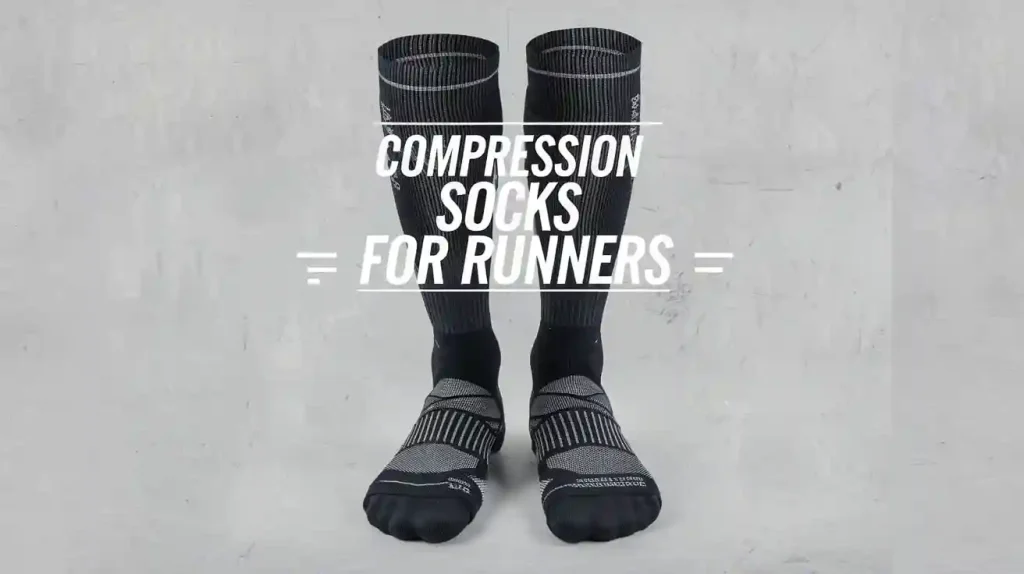
Size & Fit: Measuring Ankles and Calves for Precision
Accurate sizing is essential for compression products to work as intended. Runners should measure both their ankles and calves to choose the right fit. The socks should be snug, but not overly tight, as that could impede circulation. To determine the correct size, users should measure the narrowest part of the ankle and the widest part of the calf, then follow the manufacturer’s guide. Over-the-knee styles can offer better support by enhancing blood flow across the entire leg, which improves overall stability.
Material Matters: Nylon, Merino Wool, and Moisture Control
Custom compression socks offer significant flexibility in material selection, allowing brands to tailor their products for specific uses, whether for sports, medical purposes, or everyday wear. The choice of material plays a key role in determining the functionality, comfort, and performance of the socks. For sports compression socks, highly elastic and breathable materials like nylon, spandex, and polyester are ideal, as they help wick moisture and support high-intensity exercise. On the other hand, medical-grade compression socks focus more on comfort and antimicrobial properties, using materials such as cotton or bamboo fiber to minimize irritation and improve hygiene.
Materials like merino wool offer warmth and moisture control, making them a great choice for cooler climates or for individuals seeking extra comfort. Brands can also explore innovative fibers such as Coolmax for enhanced moisture-wicking, or graphene for added durability and temperature regulation. Depending on the target audience, custom socks can incorporate features such as anti-slip properties, additional cushioning, or a combination of materials to ensure optimal performance and comfort in every scenario.
Consumer Misconceptions About Compression Socks
“Compression Socks Are Only for Injured Athletes” (Debunked)
A common misconception is that these garments are only beneficial for athletes recovering from injuries. In reality, they offer significant advantages to healthy individuals as well. Compression socks are designed to improve circulation, reduce fatigue, and accelerate recovery, making them a valuable tool for anyone engaged in physical activity, particularly runners. By enhancing muscle support and preventing swelling, they help optimize performance, not just aid in injury rehabilitation.

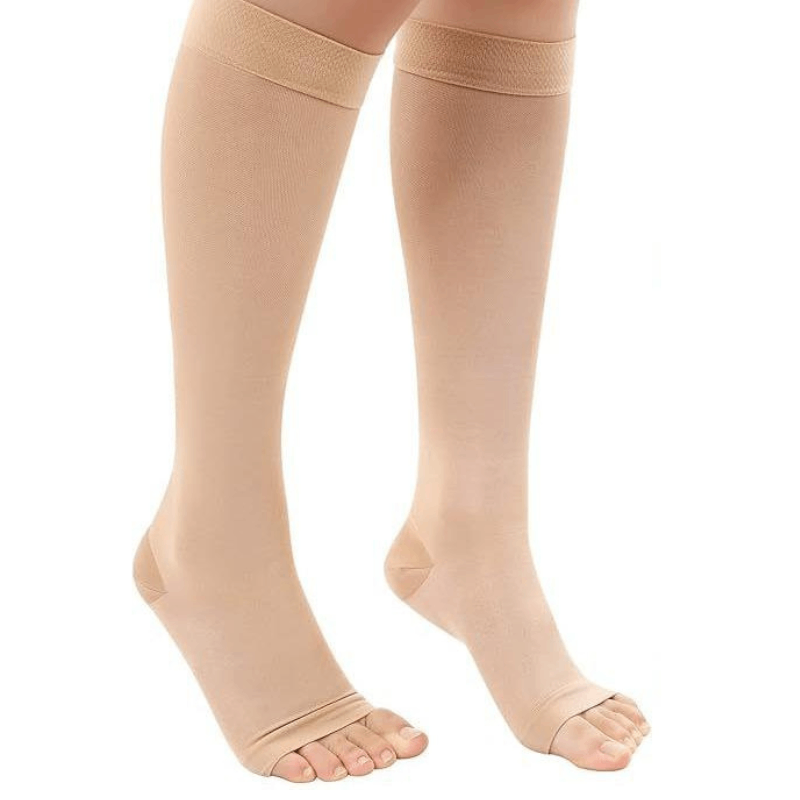
Balancing Compression Levels: Medical vs. Athletic Use
There’s often confusion between medical and athletic use when it comes to compression. While higher compression levels are used for medical reasons, such as managing varicose veins or improving circulation in individuals with specific conditions, athletic compression focuses on performance. Compression for athletes generally falls within the 15-30 mmHg range, offering muscle support and reducing soreness. Retailers should clarify these differences, helping customers choose the right level of compression based on their needs—whether for recovery or muscle support.
How to Educate Customers on Proper Fit and Sizing
Many consumers mistakenly think that all compression socks will fit the same. In reality, selecting the right size is essential to ensure maximum benefits. Socks that are too tight can impede circulation, while those that are too loose won’t provide adequate support. Educating customers about proper measurements is key—measuring the ankle and calf and referring to the manufacturer’s sizing guide will help customers find the right fit. Retailers should stress the importance of a snug fit to get the full effect of compression without causing discomfort.
The Retail Opportunity: Meeting Market Demand
- Why Brands Need Compression Gear in Their Catalog
With the growing interest in athletic performance and recovery, compression gear has become an essential product for athletes. Adding this category to a brand’s catalog presents an excellent opportunity to meet the rising demand. As consumers seek better ways to support their training and recovery, offering high-quality options will cater to a market eager for effective solutions. Compression products not only help prevent injuries but also enhance performance, which is crucial for both amateur and professional athletes.
- Positioning Compression Wear as Premium Running Essentials
Brands should strategically position compression wear as premium essentials for runners. By highlighting their benefits, such as boosting circulation, preventing muscle strain, and aiding in quicker recovery, these products can become staples in every athlete’s gear. Promoting compression wear as a necessary tool for serious runners helps elevate its status beyond basic gear, allowing brands to appeal to customers looking for high-performance, quality products that enhance their training and results.
- Bundling Strategies: Socks + Shoes + Recovery Kits
Creating bundles that combine compression socks with complementary items, like running shoes or recovery kits, offers an effective sales strategy. These packages provide customers with a comprehensive solution to their running needs, which can be particularly appealing for those looking to streamline their recovery process. Bundling not only increases the value customers receive but also encourages them to purchase multiple items at once, boosting overall sales while enhancing customer satisfaction.
- Partnering with Factories for Custom, Branded Solutions
Collaborating with factories to produce custom-branded compression socks allows retailers to stand out in a crowded market. Offering tailored designs, such as unique colors, logos, or specific performance features, can help a brand differentiate itself and appeal to its target audience. Custom solutions ensure that products meet high standards and consumer expectations, making them an attractive option for athletes who want both style and performance. Partnering directly with manufacturers also allows brands to have greater control over the quality and consistency of their products, ensuring long-term customer satisfaction.
FAQs
why do runners wear compression socks?
Compression socks improve circulation, reduce muscle fatigue, and accelerate recovery by enhancing blood flow to muscles. They also help prevent common running injuries, manage swelling, and provide comfort during long runs.
Can I customize compression socks for my running brand?
Yes, compression socks can be customized with your brand’s logo, design, colors, and even specific features like targeted compression zones or unique materials. Even custom packaging.
What compression levels can be customized for my running brand?
Compression levels can be tailored to meet your brand’s specific needs, with options typically ranging from 15-30 mmHg. This allows you to offer a range of products, from lighter support for casual runners to higher compression for those seeking enhanced muscle recovery and injury prevention.
Are custom compression socks available in eco-friendly materials?
Yes, we offer eco-friendly options for customizing compression socks, including sustainable fabrics and materials. You can choose to make your socks from organic cotton, recycled nylon, or other environmentally conscious materials to appeal to eco-conscious consumers.
Are custom compression socks available in eco-friendly materials?
Yes, many manufacturers offer eco-friendly options for customizing compression socks, including sustainable fabrics and materials. You can choose to make your socks from organic cotton, recycled nylon, or other environmentally conscious materials to appeal to eco-conscious consumers.
Can I customize the packaging for my compression socks?
Yes, you can fully customize the packaging for your compression socks. This includes custom boxes, hangtags, or branded bags, allowing you to align the packaging with your brand’s identity and provide a cohesive unboxing experience for your customers.
